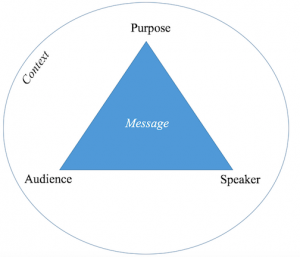
A diagram I created to show the basics of the rhetorical triangle
In “Helping Students Use Textual Sources Persuasively” Margaret Kantz uses a college student, Shirley, as an example to showcase difficulties faced by students in writing analytic research papers. Kantz points out concepts such as the rhetorical triangle which allows students to identify the rhetorical context surrounding a piece of writing. This concept is one addressed in many angles throughout pieces discussing how to write ( as we have seen in our course in quarter one). A concept that I had not heard diction for before was “rhetorical gaps“. Meaning that there is a miscommunication or misrepresentation stemming from a rhetorical disconnect between the speaker, audience, and subject.
As I have been researching for my final paper in this class I have found a rhetorical gap between speaker and subject to be prevalent. The gaps are not large but certainly exist. Part of this is due to the fact that I have been reading studies or surveys generally.
The complexity of the subject I am researching makes it difficult to design a study which does not have a disconnect between what the researcher hopes to ask and the question the data actually answers. As with any subject on a complex subjects, there are imperfections, overlooked factors, and unsolvable problems that arise. For the most part researchers of these peer-reviewed articles are able to identify these issues.
Before reading Kantz article I did not have the diction or the frame of mind to recognize I was asking similar questions in the margins of each source. Now, I can easily identify what the gap in the research is without struggling to understand my issue with the source. To use diction we explored in one of my previous articles Kantz will be a method source for my final paper.
Here is the Kantz piece in College English
